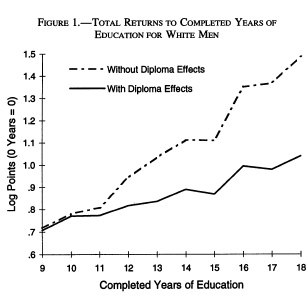If you get another year of education, how big of a raise should you expect? The answer, it turns out, heavily depends on the year. Years that typically lead to a credential – especially years 12 and 16 – pay a ton. Intermediate years pay less. This is known as the “sheepskin effect,” because diplomas used to be printed on sheepskin. (see here, here, and here for more)
One flaw with the evidence on the sheepskin effect, though, is that most data sets don’t actually measure credentials. They measure education in years. Researchers just assume that everyone with 12 years of education has a high school diploma, and everyone with 16 years of education has a B.A. Who cares? One of the neatest papers on the sheepskin effect, Jaeger and Page’s “Degree Matters” (Review of Economics and Statistics 1996), shows that this is assumption is seriously in error.
In 1992, the CPS stopped asking about years of education and started asking about credentials. Jaeger and Page take advantage of this transitional period to measure the size of the disparity:
Among individuals whose highest reported degree was a high school diploma, 91% received exactly 12 years of education, 5% took longer than 12 years, and the remaining 4% finished in less than 12 years. Only 84% of those individuals who reported finishing exactly 12 years of education received a high school diploma. Similarly, 87% of individuals with 16 years of education received a Bachelor’s degree, while 78% of those who received a Bachelor’s degree finished college in four years and 14% had more than 16 years
of education.
Next, Jaeger and Page estimate the size of sheepskin effects using both assumed credentials and actual credentials. They find that when you use actual credentials, sheepskin effects get much bigger. Using assumed credentials, the high school sheepskin effect is a statistically insignificant +3.4%, and the college sheepskin effect is +11.4%. Using actual credentials, the high school sheepskin is +12.3%, and the college sheepskin is +24.5%.*
To understand the size of these effects of actual credentials, check out Jaeger and Page’s Figure 1:
The labels in Figure 1 are slightly confusing. The solid line (“with diploma effects”) shows the return to years of education controlling for diplomas, assuming you don’t actually have any diplomas. The dashed line (“without diploma effects”) shows the return to each year of education not controlling for diplomas. The conclusion, though, is straightforward: Diploma effects are a very big deal. Notice the utter fruitlessness of years 11 and 15.
Jaeger and Page’s sheepskin effects are so large that you could dismiss them as outliers. But you probably shouldn’t. Using actual credentials is clearly preferable to using assumed credentials. There’s nothing weird about their data; when they estimate sheepskin effects the normal way, they get normal estimates. And in the General Social Survey – another large data set that measures education two ways – sheepskin effects are even bigger. See for yourself.
* Technically, this effect is so large that the log=percentage change approximation breaks down. A +.245 log-dollar effect actually means a +27.8% percentage change.
Update: The labels in Figure 1 (“without diploma effects” and “with diploma effects”) are somewhat confusing. My initial description was essentially correct, but I’ve revised the text to match the labels. Thanks to Jonathan in the comments for pointing out the problem.


READER COMMENTS
Glen S. McGhee
Jun 11 2013 at 11:11am
Florida is making a valiant attempt at tracking degree/earnings.
The methodology measures actual degrees earned in real time.
http://www.fldoe.org/fetpip/initqtrearn.asp
Hadur
Jun 11 2013 at 11:58am
Has anyone compared people who graduated college in 3 years vs people who graduated in 5 years?
ed
Jun 11 2013 at 12:01pm
Another hint is that you never, ever see a job posting that requires “16 years of education” or even “4 years of college.”
Jonathan
Jun 11 2013 at 1:44pm
The presentation is potentially confusing.
Bryan wrote: “The solid line shows what the payoff for education would be without diploma effects. The dashed line shows the actual payoff.”
The figure’s legend appears to indicate the opposite. The authors say “without diploma effects” to mean “estimated without controlling for diplomas”, while Bryan says “without diploma effects” to mean “returns to years of schooling without any value to diplomas.”
Comments are closed.